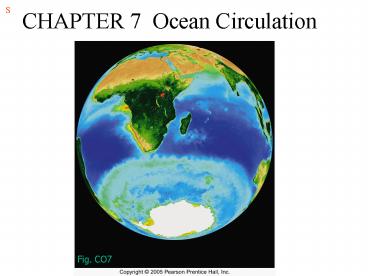CHAPTER 7 Ocean Circulation - PowerPoint PPT Presentation
1 / 52
Title:
CHAPTER 7 Ocean Circulation
Description:
... SURFACE TOPOGRAPHY MASS TRANSPORT One sverdrup = 1,000,000 cubic meters/sec Wellborn road to Texas Ave to University to George Bush Drive to the height of the O&M ... – PowerPoint PPT presentation
Number of Views:113
Avg rating:3.0/5.0
Title: CHAPTER 7 Ocean Circulation
1
CHAPTER 7 Ocean Circulation
S
Fig. CO7
2
GEOSTROPHIC (WIND-DRIVEN) CIRCULATION
S
- Surface winds
- Ekman Spiral
- Eastern and Western Boundary Currents
- Upwelling
- Surface Currents
- Gyre Formation
- Sea Surface Topography
- Mass Transport
- Gulf Stream Rings
- Gulf of Mexico Rings
3
Ocean currents and climate
P
ZONAL ISOTHERMS
Fig. 7-8a
4
SURFACE WINDS
S
5
P
Basically zonal
6
Measuring surface currents
S
Fig. 7.2
7
EKMAN SPIRAL
S
8
Ekman spiral
P
- Surface currents move at angle to wind
- Ekman spiral describes speed and direction of
seawater flow at different depths - Each successive layer moves increasingly to right
(N hemisphere)
Fig. 7.5
9
Ekman transport
P
- Average movement of seawater under influence of
wind - 90o to right of wind in Northern hemisphere
- 90o to left of wind in Southern hemisphere
Fig. 7.6
10
SURFACE CURRENTS
S
11
P
orange arrows wind yellow arrows water
12
Ocean gyres
P
- Subtropical gyres
- Centered about 30o N or S
- Equatorial current
- Western Boundary currents
- Northern or Southern Boundary currents
- Eastern Boundary currents
Fig. 7.3
13
Other surface currents
P
- Equatorial Countercurrents
- Subpolar gyres
Fig. 7.4
14
Zonal Currents (E-W)Boundary Currents (N-S)
S
15
BOUNDARY CURRENTS
S
16
PP
gt 2 knots
lt 2 knots
17
Atlantic Ocean circulation
P
- North Atlantic Subtropical Gyre
- North Equatorial Current
- Gulf Stream
- North Atlantic Current
- Canary Current
- South Equatorial Current
- Atlantic Equatorial Counter Current
18
Atlantic Ocean circulation
P
- South Atlantic Subtropical Gyre
- Brazil Current
- Antarctic Circumpolar Current
- Benguela Current
- South Equatorial Current
Fig. 7.14
19
P
20
UPWELLING
S
21
S
22
07_12a-c
S
23
Coastal upwelling
P
- Ekman transport moves surface seawater offshore
(upwelling)
Fig. 7.11a
24
Other surface currents
P
- Equatorial Countercurrents
- Subpolar gyres
Fig. 7.4
25
P
Low concentrations except in equatorial
Pacific and high latitudes at the surface
26
GULF STREAM RINGS
S
27
S
28
P
Rings, or eddies, are important because they
transfer heat, salt, plants and animals across
strong boundaries.
29
P
Gulf Stream
- Best studied
- Meanders or loops
- Warm-core rings
- Cold-core rings
- Unique biological populations
Fig. 7.16
30
S
Cold-core Rings
31
S
32
GULF OF MEXICO RINGS
S
33
P
34
(No Transcript)
35
S
36
GYRE FORMATION
S
37
PP
North Atlantic Gyre
South Atlantic Gyre
38
Geostrophic flow
P
- Ekman transport piles up water within subtropical
gyres - Surface water flows downhill (gravity) and
- Also to the right (Coriolis effect)
- Balance of downhill and to the right causes
geostrophic flow around the hill
Fig. 7.7
39
Western intensification
P
- Top of hill of water displaced toward west due to
Earths rotation - Western boundary currents intensified
- Faster
- Narrower
- Deeper
40
P
41
Converging surface seawater
P
- Surface seawater moves towards an area
- Surface seawater piles up
- Seawater moves downward
- Downwelling
- Low biological productivity
Fig. 7.10
42
SEA SURFACE TOPOGRAPHY
S
43
P
H
H
H
44
S
45
S
46
PP
Purple areas are permanently stratified
Satellite view of surface chlorophyll - purple
areas are low values red and yellow areas are
high - Note the large surface area with low
chlorophyll
47
MASS TRANSPORT
S
48
One sverdrup 1,000,000 cubic meters/sec
P
- Wellborn road to Texas Ave to University to
George Bush Drive to the height of the OM
Building in 2.75 minutes - Peak flood flow of the Mississippi River is .03
sv.
Peak flood flowof the Mississippi River is .03 sv.
49
S
Numbers are sverdrups (millions of cubic meters
per sec) and the flow on the eastern boundary
must equal that on the west, therefore, slower
broader flow on the east means narrower, faster
flow in the west.
50
GEOSTROPHIC (WIND-DRIVEN) CIRCULATION
S
- Surface winds
- Ekman Spiral
- Eastern and Western Boundary Currents
- Upwelling
- Surface Currents
- Gyre Formation
- Sea Surface Topography
- Mass Transport
- Gulf Stream Rings
- Gulf of Mexico Rings
51
S
52
S































